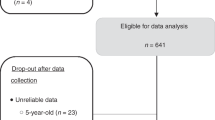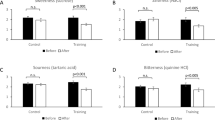Abstract
SENSITIVE quinine taste responders, that is, subjects with low taste thresholds for quinine and other compounds the taste thresholds of which also follow a Gaussian distribution in a population9, are more particular in their choice of food1,2, react earlier and in response to smaller doses of systemic stimulants3 or tranquillizers4 and display faster reaction times as measured by the serial seven test5. There are also significantly fewer heavy cigarette smokers among sensitive quinine responders as a group if contrasted with an age and sex-matched population of subjects with high quinine taste thresholds1,6.
This is a preview of subscription content, access via your institution
Access options
Subscribe to this journal
Receive 51 print issues and online access
$199.00 per year
only $3.90 per issue
Buy this article
- Purchase on Springer Link
- Instant access to full article PDF
Prices may be subject to local taxes which are calculated during checkout
Similar content being viewed by others
References
Fischer, R., Griffin, F., England, S., and Garn, S., Nature, 191, 1328 (1961).
Fischer, R., Griffin, F., and Kaplan, A. R., Med. Exp., 9, 151 (1963).
Fischer, R., Griffin, F., Archer, R. C., Zinsmeister, S. C., and Jastram, P. S., Nature, 207, 1049 (1965).
Fischer, R., Knopp, W., and Griffin, F., Arzneimittel-Forsch., 15, 1379 (1965).
Fischer, R., Griffin, F., and Rockey, M. A., Persp. Biol. Med., 9, 549 (1966).
Kaplan, A. R., Glanville, E. V., and Fischer, R., J. Gerontol., 20, 334 (1965).
Myers, I. B., in The Myers-Briggs Type Indicator (Princeton, N. J., Educational Testing Service, 1962).
Harris, H., Kalmus, H., Ann. Eugen. 14, 24 (1949).
Fischer, R., and Griffin, F., Arzneimittel-Forsch., 14, 673 (1964).
Fischer, R., Griffin, F., and Mead, E. L., Med. Exp., 6, 177 (1962).
MacKinnon, D. W., in Personality Assessment (edit. by Semeonoff, B.) (Penguin Books, Baltimore, 1966).
Vandenberg, S. G., Psychol. Bull., 66, 327 (1966).
See Fischer, R., in The Chemical Senses and the Nutritive Processes (edit. by Kare, M. R., and Maller, O.) (Johns Hopkins Press, Baltimore, 1967).
Author information
Authors and Affiliations
Rights and permissions
About this article
Cite this article
CORLIS, R., SPLAVER, G., WISECUP, P. et al. Myers–Briggs Type Personality Scales and their Relation to Taste Acuity. Nature 216, 91–92 (1967). https://doi.org/10.1038/216091a0
Received:
Revised:
Issue Date:
DOI: https://doi.org/10.1038/216091a0
This article is cited by
-
An electroencephalographic analysis of personality-dependent performance under psilocybin
Agents and Actions (1971)
-
Taste Acuity in relation to Hunger
Nature (1969)
-
Measurement of handwriting area to pressure ratios during psilocybin-induced hallucinations
Agents and Actions (1969)
-
Personality Structure as the Main Determinant of Drug Induced (Model) Psychoses
Nature (1968)
Comments
By submitting a comment you agree to abide by our Terms and Community Guidelines. If you find something abusive or that does not comply with our terms or guidelines please flag it as inappropriate.



